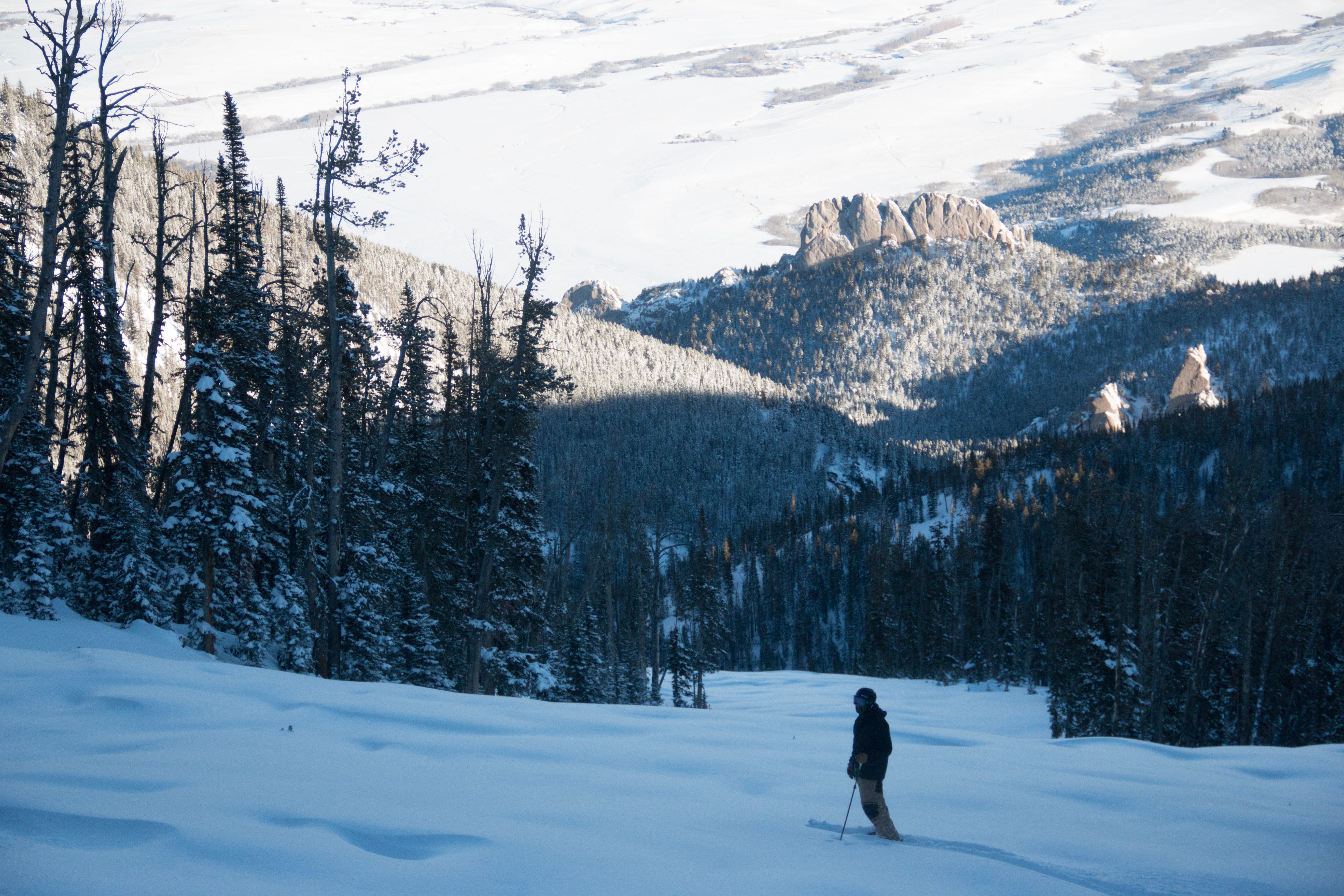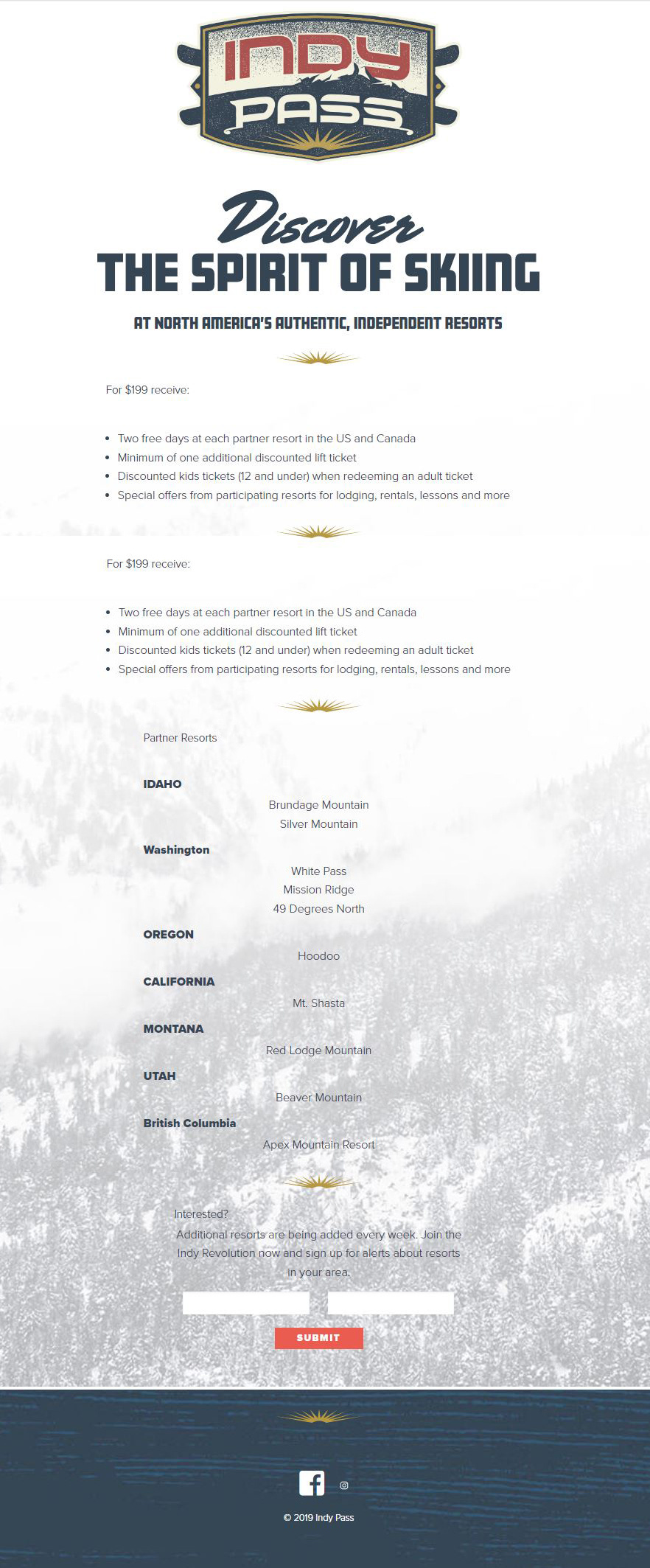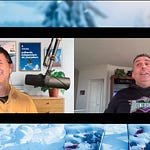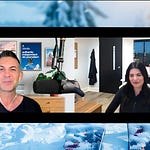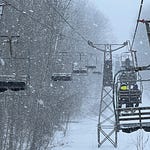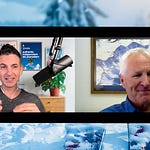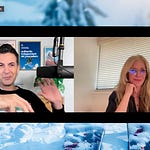Who
Doug Fish, president and founder of the Indy Pass
Recorded on
The majority of this conversation took place on April 3, 2023. Three days later, I left for a Montana ski trip, with the intent of releasing this either on the trip or when I returned. A week later, however, news broke that Indy would (at least temporarily) cease pass sales for 2023-24 products on April 11, making a small portion of our conversation irrelevant. Fish and I then recorded a new segment focused specifically on the decision to halt pass sales, on April 20, 2023. This section also includes a recap of the top 10 Indy Pass resorts for the 2022-23 ski season.
About the Indy Pass
Indy Pass is the coolest thing going. If Indy were a person, everyone would gloss him “IP.” In the ‘80s, IP would have rolled in a Firebird with T-tops off and a flame-eagle emblazoned upon the hood. Or in a door-less Jeep with his boys gripping the rollbar, feathered-hair and sunglasses cool. Or rocking a skateboard, Walkman, and jean jacket, Michael J. Fox-style, transforming into a werewolf or traveling through time in a fucking DeLorean. IP’s not the most popular kid. In fact the cool kids, in their poloshirts and loafers, don’t care much for the interloper at all. But we all see a bit of ourselves in the young rogue, middle finger aimed at the social-status gatekeepers and their lackies, flouting conventions of deference and sobriety, in possession of secret powers that will scare them once they know. IP is our hero because we are him. Or he’s a supercharged superhero cartoon version of us. Or because he is whatever the hell he wants to be. IP rules!
Or, if that doesn’t work for you, how about this: IP is a season-long ski product that delivers up to 210 days of alpine skiing for four dollars more than the price of a one-day walk-up peak-day lift ticket at Vail or Beaver Creek. “Yeah but it’s not Vail or Beaver Creek, Man – don’t you get that?” I sure do, Biff. And I love both mountains, but give me the choice of one serving of caviar or a pizza every day all season long, and I gotta roll pizza, my friend (this is the 2022-23 roster; ignore the prices, ignore the blackouts. The robots are still fighting my efforts to update this chart for 2023-24. The only ski area that we know will change as of now is Snow Valley, which ran off with the Ikon Pass):
More partners are inbound. Perhaps not as many as the 58 new ski areas (25 alpine, 19 cross-country, and 14 Allied), that signed onto Indy over the 2022 offseason. But I already have a partial list, and it will be at least a dozen. Perhaps many more as Indy looks to turboboost its XC roster.
Too bad you already missed the best price: $279 for renewing passholders, $299 for waitlistees, $319 for the disorganized masses. Indy is currently off sale. It may come back in the fall. How will you know? Subscribe to their notifications, and they will send you eight to 12 emails and texts per day about it once the time comes. In the meantime, activate learning mode and enjoy this IP 101.
Why I interviewed him
Doug Fish is one of skiing’s class acts. He’s built a product that works. For skiers, for ski area operators, and for him and everyone working for him. This is not Liftopia 2.0, an online discount center where money falls into a blackhole. When you buy an Indy Pass, 15 percent of that money goes to Indy, the other 85 percent goes directly to the ski areas. You get a bargain, they get paid. Everyone wins.
This whole thing could have been a scam. Or a crock. Or a fiasco. It could have disintegrated in a storm of partner and passholder anger over dysfunctional tech or missing paychecks or unregistered skier accounts. It could have been Fyre Ski – show up and there’s nothing there.
That was my fear the first time I cashed in my Indy Pass, at Caberfae, Michigan, on Friday, Nov. 29, 2019. I approached the ticket window and informed the clerk that I had an Indy Pass. She stared at me as though I’d just asked her which way to the kitten fur-hat section. Indy had just launched – I probably redeemed the first lift ticket in the ski area’s history. But Pete Meyer, part-owner and GM, was standing right behind her, and he nodded and I nodded (this was the month after The Storm launched, and we were not yet acquainted), and I attached my metal wicket ticket to my jacket and went skiing.
I’ve never had an issue cashing in an Indy Pass ticket since. Neither has anyone else that I’ve talked to. That’s why the passholder base is exploding to the point that Indy has suspended sales. And that consistency – in the form of (mostly) hassle-free redemptions and steady paychecks, is why 104 out of 105 alpine partners are returning to the pass for the 2022-23 ski season. The only exception is Snow Valley, a two-season partner that surely would have returned had it not been devoured by Alterra Mountain Company and notched into the Ikon Pass ammo belt.
For someone who has built something so transcendent, Fish remains modest and humble, at least in his public dealings and those with the media. He answers texts and emails. He takes hard questions. He owns his mistakes. He fulfills his promises. He gives everything he has to making this thing that he created work.
The Indy Pass could have come from just about anywhere. It could have been a monetized version of the Powder Alliance or sprung from an alt-world Liftopia or formed from a regurgitated M.A.X. Pass or been some sort of quirky Wal-Mart version of a 1980s Christmas catalogue special G.I. Joe boxset – a cool niche product that is kind of hard to get but coveted by those whose existence is defined by their fringe knowledge.
That IP came from Portland Doug, with his West Coast chill and self-aware need to preserve peace in Skidom – and, by extension, his own reputation – is a blessing to us all. This career marketing guy with a love of Hood pow and a knack for actualizing good ideas turned out to be exactly the shepherd indie skiing needed.
Because of this remarkable thing Fish has created, he’s been on the podcast four times. But I’ve never bothered asking about his story until now. Who is this person that spun the Indy Pass out of his imagination? Where did he come from, and why did he turn out to be the proper hero for the moment, not only creating this ark but steering it through the asteroid belts of Covid and evergrowing Epkon Pass sales? That’s a big part of what I was after here, and Fish, as always, delivered.
What we talked about
Why Fish sold the Indy Pass, how he’s feeling about it, and what his role is now; “the only reason you start a business is to someday sell it”; the hardest part of walking away from Indy; the highs and lows of creating and managing the Indy Pass; Indy’s mass adoption; Entabeni Systems, Indy’s new owner; Indy’s plan to massively expand its Nordic program; the first year of Indy XC; the most popular Indy XC resorts; how close Indy was to partnering with a tech company other than Entabeni, how Entabeni won the contract, and how that switch set Indy up for long-term business success; the first non-Western ski area to join Indy; what may or may not change in how the Indy Pass works; how often skiers actually use their Indy Passes; the surprising ownership alternative that Fish considered for Indy; the challenge of scaling the Indy Pass from 10 partners to 139 in four years; the impact of Indy’s 40 percent 2021-22 price increase in retrospect; comparing what the Indy Pass is currently to what Fish thought the Indy Pass would be five years ago; whether we could see more density in already-dense Indy regions; are oversold Epic and Ikon passes benefitting Indy?; can Indy Pass last a decade or longer?; what could ruin the pass; Portland and the Mt. Hood ski scene, in the 1960s and now; “if you envy someone for what they do, then you should be doing that thing”; the advantage of starting something huge in your 60s; why Indy will switch to a physical pass for the 2023-24 ski season; how Indy has been able to largely retain its ski area partner roster and how important that is; how Jay Peak changed the pass forever; why Indy Pass signs one-year contracts with its partners, and whether that could change; oh Dear Lord what have I done I used the word “brand equity” without irony sorry; what would have happened had Indy lost Jay; why Indy kept Jay even though it is now part of a small ski area conglomerate; whether Jay owner Pacific Group Resorts could add any of its other five ski areas to Indy; why Indy may not announce any new partners until fall; what Indy Pass blackout tiers will look like for the 2023-24 ski season; how Indy Passes sold during the renewal, waitlist, and general public sales periods; why Indy limited and ultimately cut off pass sales for the 2023-24 ski season; the problem that blackouts can’t solve; trying not to break the machine; how Indy will determine whether passes will go back on sale in the fall; new partners inbound; the top 10 Indy Pass partners by number of redemptions for the 2022-23 ski season; and the newest member of the Indy top 10 club.
Why I thought that now was a good time for this interview
Fish appears on the podcast as regularly as the snow melts.
May 27, 2020 (Storm Skiing Podcast #16):
April 27, 2021 (Storm Skiing Podcast # 45):
May 9, 2022 (Storm Skiing Podcast #85):
So every 40 podcasts or so. And here he is, back again exactly on cue, with podcast number 125. He would have been here no matter what, to discuss the ever-evolving, ever-fascinating Indy Pass. We could probably fill an hour every month of the year. But this year is different: in March, Fish sold Indy Pass to longtime tech partner Entabeni Systems. Wow. It seemed like IP just rolled into the party. And now all this. What gives, man? And why can’t my boy Stiles scoop up an Indy just because he was busy picking out his new speakers at the boombox store for the past three weeks? And why are you mailing me a pass like it really is 1985? And do I still get my two days at Jay Peak? And when are you actually gonna add Tahoe man cause my cousin said it was sick out there? And since you’re mailing a pass can you throw in some stickers Brah? So much to dig into.
Why you should consider the Indy Pass
Well do you like skiing? Do you like selling your grandmother’s heirloom candlesticks to pay for skiing (terrible example, actually, as candles and all related paraphernalia out to be recycled into a giant bouncy ball and shot into space to create a second moon). If you answered “yes” to the first question and “no” to the second, then the Indy Pass might be for you.
One of the worst takes in skiing is that there’s nothing on the Indy Pass “worth” traveling out West for. I would have to walk into a McDonald’s and observe people eating their rancid food to witness a dumber idea. Indy’s northern Rockies kingdom is stacked with launchpads larger than anything in New England: Mission Ridge, 2,250 vertical feet on 2,000 acres of skiable terrain; Mt. Hood Meadows, 2,777 feet/2,150 acres; Lost Trail, 1,800 feet/1,800 acres; Brundage, 1,921 feet/1,920 acres.
That’s just the start of the list. If you’re an eastern or Midwestern skier who lives anywhere within the Indy orbit, this one super-cheapo discount product can give you an over-the-top amazing ski season. Buy an Indy Pass. Then hit all your locals. Then hit them all again. Then fly or drive of #VanLife your way west and loop the circuit. You get the western pow and the western vibe and the wide-open western glades without the western destination-town alienation and crowds.
For years I was that guy who flew west and blew right past Loveland on my way to Copper or Keystone or Breck or Vail. But I’m not that guy anymore. I still love – will always love – the megaresorts of the American West. But last week, after an outstanding six days at Big Sky, I angled east toward Red Lodge, seated on the Montana side of Beartooth Pass. It was sprawling, gorgeous, glorious and empty. Admittedly, the conditions kind of sucked. But they’d sucked the day before at Big Sky too – a storm had cargoed in three inches after a big thaw. Dust-on-crust? More like dust-on-concrete. But that, according to everyone I spoke with at both ski areas, had been the first thaw all winter. This is Montana high country, oases rising out of the flats. The architecture of the mountains, the dreamily spaced trees, the steady fall lines, the broad ski-everything kingdom, promised something glorious another day.
I found it the next day, at Great Divide, a little-known but riotous locals’ bump off I-15 outside of Helena. A 1,500-foot vertical drop on 1,600 acres, split into three or four treed bowls served by open-basket Riblet doubles. Four or five inches from an overnight storm, mostly smooth base below. A half-dozen whooping runs. What felt like limitless lines. No liftlines at all. Even on a Saturday. Just skiing. Skiing skiing skiing. All day long in the Montana backwoods.
Great Divide is not an Indy Pass partner, but it could (and should) be. Family-owned, rich in vibe and attitude, complex and glorious in its sprawling terrain, empty of pretense and a knick-knack souvenir veneer. If you want a cheeseburger, it’s $8.50. If you want a T-shirt, you buy it in the rental shop, which is also the ticket desk, which also appears to be the main office. There’s a good chance one of the four owners will be there working the register. I think this is what Fish means when he describes a mountain as “authentic.” Which seems to mean people running a ski area like it’s a family sandwich shop, with everyone doing what they can at all times to make it work.

This version of skiing is not for everyone. Some people really want that #ExperienceOfALifetime hashtag on their Instapost. But if you’re a little bit over that, or just want a break from it once in a while, well, jump on that IP email list and plan to pick one up this fall.
Podcast Notes
On retro Indy
Retro Indy is a funny notion, as the website flipped live less than a goldfish’s lifetime ago. But a look at this landing page, captured by the Wayback Machine on March 17, 2019, underscores how fast Indy has grown:
On Snowvana
Fish talked about his Northwest “stoke festival,” Snowvana, which has become an annual Portland tradition. You can learn about it here.
On Peak Performance aging
On a 10-hour drive from South Tahoe to San Diego last month, I streamed an episode of The Reinvention Project with Jim Rome that featured author Steven Kotler. He’d recently written a book called Growing Old, Staying Rad, which exposes myths around physical and mental degeneration and aging. One giant takeaway: your skills only decline if you let them. I brought this up in the context of Doug’s career because he created the Indy Pass at age 62, a cultural waypoint at which most Americans are hypnotized to believe their most productive time is past them. And here Fish creates one of the greatest products in skiing in his seventh decade. It’s a remarkable anecdote that proves Kotler’s point and underscores the incredible power of moving forever forward.
I have been listening to Jim Rome’s daily sports talk radio show for decades, and my interview style largely mimics his. This one is well worth a listen if you’re at all interested in aging with style:
On the Indy Pass top 10
In the podcast, Fish lays out the top-10 most-redeemed Indy Pass ski areas for the 2022-23 ski season. Here they are:
1) Jay Peak
2) Waterville Valley
3) Cannon Mountain
4) Pats Peak
5) Bolton Valley
6) Saddleback
7) Magic Mountain
8) Berkshire East
9) Powder Mountain
10) Lutsen Mountains
And here’s what the list looks like year-by-year since Indy’s inaugural season:
Most of the sliding around between this season and last can be attributed to blackout dates: Lutsen and Pats Peak increased theirs and thus slid in the rankings. Cannon reduced theirs and so advanced. And then there’s Saddleback:
On Saddleback blackouts
Fish notes that Saddleback was a first-time entrant into the Indy Pass top 10. There was no mystery as to why: “A lot of resorts in New England added blackouts, Saddleback took theirs away,” for the 2021-22 ski season, Fish tells me on the podcast.
Saddleback General Manager Jim Quimby and I discussed exactly this, and how crucial Indy Pass has been to the mountain’s renaissance since re-opening in 2020 after a five-year closure, in our recent podcast conversation (1:28):
Honestly though just listen to the whole thing. Quimby delivers the rich history of Saddleback with an unforgettable series of anecdotes, reflections, and emotion. One of the best episodes I have to offer.
The Storm publishes year-round, and guarantees 100 articles per year. This is article 38/100 in 2023, and number 424 since launching on Oct. 13, 2019. Want to send feedback? Reply to this email and I will answer (unless you sound insane, or, more likely, I just get busy). You can also email skiing@substack.com.





